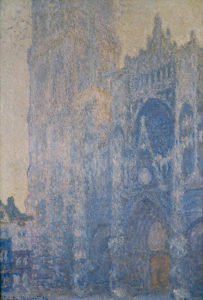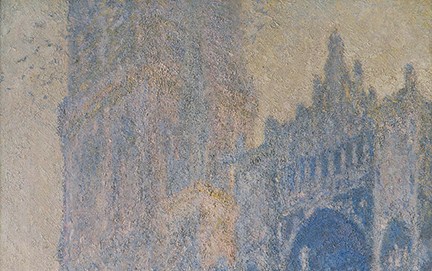24 May 2018
Monet & Architecture
The National Gallery (9th April – 29th July)
By William Morton

The title of this exhibition is a bit misleading. It leads one to think that it will only be studies of great buildings such as Rouen Cathedral. A more accurate title, if somewhat prosaic, would be ‘Monet’s paintings of buildings and not just water lilies and poplars’. However, this a minor quibble for this is a magnificent show.
Monet (1840-1926) was born in Paris but brought up in Le Havre. Before settling in Giverny of water lilies fame, he lived in various towns and villages in northern France and in London during the Franco-Prussian War. Unlike many artists, his private life was apparently blameless and he out-lived two wives. He made productive trips to Holland, the Normandy Coast, the Riviera and Venice. He was, of course, a founding member of the Impressionists and friends with Renoir and Pissarro. There are pictures in the exhibition which are reminiscent of both – Street in Sainte-Adresse of Pissarro and Gardener’s House at Antibes and The Boulevard des Capucines, Paris of Renoir.
Monet’s particular genius was the immediacy of his paintings and his ability in recreating the effects of light. At the risk of being banal, you do get the sense you are there. Fine examples of this in the exhibition are the well-known Gare Saint Lazare, The Rue Montorgueil, The National Holiday of 30 June 1878, Sailing Boat at Petit-Gennevilliers and Antibes, Morning. Many depict with enormous skill the reflection on water such as Houses on the Bank of the Zaan, Zaandam and Argenteuil, the Bridge under Repair. The effect of differing light is also the inspiration for the Rouen Cathedral series.
In spite of his subject matter, Monet never comes close to being a ‘chocolate-box’ painter even in his Riviera scenes such Villas at Bordighera. Indeed, in his Venice paintings such as those of San Giorgio Maggiore, the absence of human figures produces a strong sense of depopulated faded glory.
Although Monet was perfectly prepared to omit features or adjust a landscape, the paintings frequently depict modern life and industry and commerce. In those of Argenteuil, where he lived for some years, factory chimneys indicate the town’s increasing industrialisation. Paintings of the Thames show trains going into Charing Cross and steam launches. One, The Coal-heavers, showing barges being unloaded by a chain of drab uniform figures, stands out because it has to be seen as social comment, usually totally absent from Monet’s work.
Monet was not a painter of human nature. While many of the pictures on show include people, they are small scale and there is no attempt to characterise them in the way that, for example, Manet did in his work. That was not something which interested Monet, but his painting of subjects which did appeal to him are superb as this exhibition amply demonstrates.


